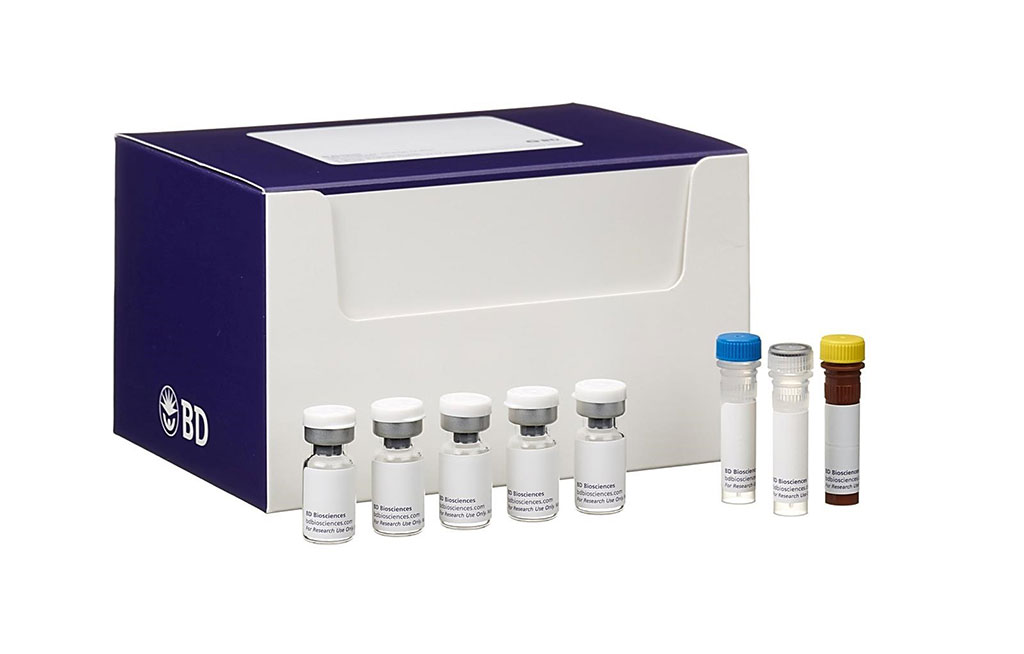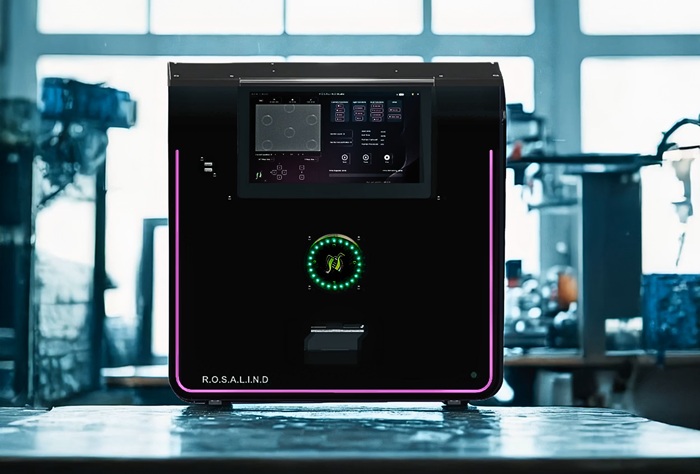Elevated Soluble C5b9 Biomarker Found in SARS-CoV-2 Infected Children
|
By LabMedica International staff writers Posted on 21 Dec 2020 |

Image: BD enzyme-linked immunosorbent assays for natural C5b-9 in serum, plasma, and other biological samples (Photo courtesy of BD Biosciences).
Most children with severe acute respiratory syndrome coronavirus 2 (SARS-CoV-2) infections have mild or minimal disease, with a small proportion developing severe disease or multisystem inflammatory syndrome in children (MIS-C).
A small proportion of acutely infected children, typically adolescents with significant comorbidities, develop severe respiratory symptoms requiring hospitalization or admission to the pediatric intensive care unit. High rates of thrombosis and thrombotic-related complications have been reported in adult patients with severe COVID-19.
A multidisciplinary team of medical scientists associated with the Children's Hospital of Philadelphia (Philadelphia, PA, USA) analyzed 50 pediatric patients, hospitalized at the Children’s Hospital of Philadelphia with acute SARS-CoV-2 infection between April 3 and July 7, 2020. Of the patients, 21 had minimal COVID-19 (median age, 13 years), or those with mild COVID-19 symptoms that did not require noninvasive mechanical ventilation, 11 had severe COVID-19 (median age, 15 years), while 18 were diagnosed with MIS-C (median age, 9 years). Additionally, 10% of minimal COVID-19, 36% of severe COVID-19, and 28% of MIS-C patients had evidence of acute kidney injury (AKI).
Blood draws were obtained in conjunction with the first clinical blood draw after consent was obtained, within the first two weeks of the positive SARS-CoV-2 test or admission for MIS-C. For most patients, blood samples were obtained within 48 hours of admission. Ten proinflammatory cytokines were measured (interferon-γ, interleukin IL-1β [IL-1β], IL-2, IL-4, IL-6, IL-8, IL-10, IL-12p70, IL-13, and tumor necrosis factor-α) using V-Plex Pro-inflammatory Panel 1 Human Kits (Meso Scale Diagnostics, Rockville, MD, USA). Assays were read and analyzed on a Meso Scale Diagnostics QuickPlex SQ120. Plasma samples were assayed for serum C5b9 (sC5b9) at 2 dilutions by using a human C5b9 enzyme-linked immunosorbent assay (ELISA) set (BD Biosciences, San Jose, CA, USA).
The scientists reported that sC5b9 levels were elevated in patients with minimal disease (median, 392 ng/mL; interquartile range [IQR], 244-622 ng/mL), severe disease (median, 646 ng/mL; IQR, 203-728 ng/mL), and MIS-C (median, 630 ng/mL; IQR, 359-932 ng/mL) compared with those of 26 healthy control subjects (median, 57 ng/mL; IQR, 9-163 ng/mL). In addition, significantly higher sC5b9 levels were observed in patients with AKI (717 ng/mL; IQR, 404-1232 ng/mL) than in those without AKI (433 ng/mL; IQR, 232-706 ng/mL).
Meanwhile, among patients with severe COVID-19 and MIS-C, sC5b9 did not correlate significantly with markers of inflammation, hemolysis, and coagulopathy, including ferritin, C-reactive protein, LDH, prothrombin time, partial thromboplastin time, fibrinogen, D-dimer, aspartate transaminase, hemoglobin, and platelets. The team retrospectively evaluated a subgroup of 19 patients who had a blood smear, complete blood count, and lactate dehydrogenase level available, 17 (89%) met clinical criteria for thrombotic microangiopathy (TMA).
Caroline Diorio, MD, FRCPC, FAAP, a hematology and oncology specialist and first author of the study, said, “Complement-mediated TMA has been associated with SARS-CoV-2 infection in adults but has not been studied in the pediatric population. SC5b9 is a clinically available biomarker and has been implicated as an indicator of severity in hematopoietic stem cell transplant-associated TMA, as patients with markedly elevated sC5b9 have increased mortality.” The study was published on December 8, 2020 in the journal Blood Advances.
Related Links:
Children's Hospital of Philadelphia
Meso Scale Diagnostics
BD Biosciences
A small proportion of acutely infected children, typically adolescents with significant comorbidities, develop severe respiratory symptoms requiring hospitalization or admission to the pediatric intensive care unit. High rates of thrombosis and thrombotic-related complications have been reported in adult patients with severe COVID-19.
A multidisciplinary team of medical scientists associated with the Children's Hospital of Philadelphia (Philadelphia, PA, USA) analyzed 50 pediatric patients, hospitalized at the Children’s Hospital of Philadelphia with acute SARS-CoV-2 infection between April 3 and July 7, 2020. Of the patients, 21 had minimal COVID-19 (median age, 13 years), or those with mild COVID-19 symptoms that did not require noninvasive mechanical ventilation, 11 had severe COVID-19 (median age, 15 years), while 18 were diagnosed with MIS-C (median age, 9 years). Additionally, 10% of minimal COVID-19, 36% of severe COVID-19, and 28% of MIS-C patients had evidence of acute kidney injury (AKI).
Blood draws were obtained in conjunction with the first clinical blood draw after consent was obtained, within the first two weeks of the positive SARS-CoV-2 test or admission for MIS-C. For most patients, blood samples were obtained within 48 hours of admission. Ten proinflammatory cytokines were measured (interferon-γ, interleukin IL-1β [IL-1β], IL-2, IL-4, IL-6, IL-8, IL-10, IL-12p70, IL-13, and tumor necrosis factor-α) using V-Plex Pro-inflammatory Panel 1 Human Kits (Meso Scale Diagnostics, Rockville, MD, USA). Assays were read and analyzed on a Meso Scale Diagnostics QuickPlex SQ120. Plasma samples were assayed for serum C5b9 (sC5b9) at 2 dilutions by using a human C5b9 enzyme-linked immunosorbent assay (ELISA) set (BD Biosciences, San Jose, CA, USA).
The scientists reported that sC5b9 levels were elevated in patients with minimal disease (median, 392 ng/mL; interquartile range [IQR], 244-622 ng/mL), severe disease (median, 646 ng/mL; IQR, 203-728 ng/mL), and MIS-C (median, 630 ng/mL; IQR, 359-932 ng/mL) compared with those of 26 healthy control subjects (median, 57 ng/mL; IQR, 9-163 ng/mL). In addition, significantly higher sC5b9 levels were observed in patients with AKI (717 ng/mL; IQR, 404-1232 ng/mL) than in those without AKI (433 ng/mL; IQR, 232-706 ng/mL).
Meanwhile, among patients with severe COVID-19 and MIS-C, sC5b9 did not correlate significantly with markers of inflammation, hemolysis, and coagulopathy, including ferritin, C-reactive protein, LDH, prothrombin time, partial thromboplastin time, fibrinogen, D-dimer, aspartate transaminase, hemoglobin, and platelets. The team retrospectively evaluated a subgroup of 19 patients who had a blood smear, complete blood count, and lactate dehydrogenase level available, 17 (89%) met clinical criteria for thrombotic microangiopathy (TMA).
Caroline Diorio, MD, FRCPC, FAAP, a hematology and oncology specialist and first author of the study, said, “Complement-mediated TMA has been associated with SARS-CoV-2 infection in adults but has not been studied in the pediatric population. SC5b9 is a clinically available biomarker and has been implicated as an indicator of severity in hematopoietic stem cell transplant-associated TMA, as patients with markedly elevated sC5b9 have increased mortality.” The study was published on December 8, 2020 in the journal Blood Advances.
Related Links:
Children's Hospital of Philadelphia
Meso Scale Diagnostics
BD Biosciences
Latest Hematology News
- MRD Tests Could Predict Survival in Leukemia Patients
- Platelet Activity Blood Test in Middle Age Could Identify Early Alzheimer’s Risk
- Microvesicles Measurement Could Detect Vascular Injury in Sickle Cell Disease Patients
- ADLM’s New Coagulation Testing Guidance to Improve Care for Patients on Blood Thinners
- Viscoelastic Testing Could Improve Treatment of Maternal Hemorrhage
- Pioneering Model Measures Radiation Exposure in Blood for Precise Cancer Treatments
- Platelets Could Improve Early and Minimally Invasive Detection of Cancer
- Portable and Disposable Device Obtains Platelet-Rich Plasma Without Complex Equipment
- Disposable Cartridge-Based Test Delivers Rapid and Accurate CBC Results
- First Point-of-Care Heparin Monitoring Test Provides Results in Under 15 Minutes

- New Scoring System Predicts Risk of Developing Cancer from Common Blood Disorder
- Non-Invasive Prenatal Test for Fetal RhD Status Demonstrates 100% Accuracy
- WBC Count Could Predict Severity of COVID-19 Symptoms
- New Platelet Counting Technology to Help Labs Prevent Diagnosis Errors
- Streamlined Approach to Testing for Heparin-Induced Thrombocytopenia Improves Diagnostic Accuracy
- POC Hemostasis System Could Help Prevent Maternal Deaths
Channels
Clinical Chemistry
view channel
POC Breath Diagnostic System to Detect Pneumonia-Causing Pathogens
Pseudomonas aeruginosa is a major cause of hospital-acquired and ventilator-associated pneumonia, particularly in lung transplant recipients and patients with structural lung disease. Its ability to form... Read more
Online Tool Detects Drug Exposure Directly from Patient Samples
Doctors often rely on patient interviews and medical records to determine what medications a person has taken, but this information is frequently incomplete. People may forget drugs they used, take over-the-counter... Read moreMolecular Diagnostics
view channel
Rapid Diagnostic Breakthrough Simultaneously Detects Resistance and Virulence in Klebsiella Pneumoniae
Antibiotic resistance is a steadily escalating threat to global healthcare, making common infections harder to treat and increasing the risk of severe complications. One of the most concerning pathogens... Read more
DNA Detection Platform Enables Real-Time Molecular Detection
A next-gen DNA detection platform enables real-time molecular detection by detecting nucleic acids directly without enzymes or thermocyclers, thereby slashing costs, reducing complexity, and boosting reliability... Read moreImmunology
view channel
Blood Test Could Identify Colon Cancer Patients to Benefit from NSAIDs
Colon cancer remains a major cause of cancer-related illness, with many patients facing relapse even after surgery and chemotherapy. Up to 40% of people with stage III disease experience recurrence, highlighting... Read moreBlood Test Could Detect Adverse Immunotherapy Effects
Immune checkpoint inhibitors have transformed cancer treatment, but they can also trigger serious immune-related adverse events that damage healthy organs and may become life-threatening if not detected early.... Read moreMicrobiology
view channel
Breakthroughs in Microbial Analysis to Enhance Disease Prediction
Microorganisms shape human health, ecosystems, and the planet’s climate, yet identifying them and understanding how they are related remains a major scientific challenge. Even with modern DNA sequencing,... Read more
Blood-Based Diagnostic Method Could Identify Pediatric LRTIs
Lower-respiratory tract infections (LRTIs) are a leading cause of illness and death worldwide, and pneumonia is the leading infectious cause of death in children under five, claiming the lives of over... Read morePathology
view channel
Rapid Low-Cost Tests Can Prevent Child Deaths from Contaminated Medicinal Syrups
Medicinal syrups contaminated with toxic chemicals have caused the deaths of hundreds of children worldwide, exposing a critical gap in how these products are tested before reaching patients.... Read more
Tumor Signals in Saliva and Blood Enable Non-Invasive Monitoring of Head and Neck Cancer
Head and neck cancers are among the most aggressive malignancies worldwide, with nearly 900,000 new cases diagnosed each year. Monitoring these cancers for recurrence or relapse typically relies on tissue... Read more
Common Health Issues Can Influence New Blood Tests for Alzheimer’s Disease
Blood-based tests for Alzheimer’s disease are transforming diagnosis by offering a simpler alternative to spinal taps and brain imaging. However, many people evaluated at memory clinics also live with... Read more
Blood Test Formula Identifies Chronic Liver Disease Patients with Higher Cancer Risk
Chronic liver disease affects millions worldwide and can progress silently to hepatocellular carcinoma (HCC), one of the deadliest cancers globally. While surveillance guidelines exist for patients with... Read moreTechnology
view channel
Machine Learning Models Diagnose ALS Earlier Through Blood Biomarkers
Amyotrophic lateral sclerosis (ALS) is a rapidly progressive neurodegenerative disease that is notoriously difficult to diagnose in its early stages. Early symptoms often overlap with other neurological... Read more
Artificial Intelligence Model Could Accelerate Rare Disease Diagnosis
Identifying which genetic variants actually cause disease remains one of the biggest challenges in genomic medicine. Each person carries tens of thousands of DNA changes, yet only a few meaningfully alter... Read moreIndustry
view channel
BD and Penn Institute Collaborate to Advance Immunotherapy through Flow Cytometry
BD (Becton, Dickinson and Company, Franklin Lakes, NJ, USA) has entered into a strategic collaboration with the Institute for Immunology and Immune Health (I3H, Philadelphia, PA, USA) at the University... Read more






















